Effect of Curing Parameter on the Performance of Electric-Induced Heating-Cured Carbon Fiber-Reinforced Conductive Cement-Based Materials: Experiment and Finite Element Method Analysis
Abstract
1. Introduction
2. Materials and Methods
2.1. Raw Materials
2.2. Mix Proportion
2.3. Preparation Methods
2.4. Curing Regime
2.5. Test Methods
2.5.1. Electric Resistance Test
2.5.2. Mechanical Strength Test
2.5.3. Temperature Test
2.6. Finite Element Modeling Analysis
3. Results and Discussion
3.1. Effect of CFs on the Electrical Properties
3.2. Effect of Preparation Method on the Mechanical Properties
3.3. Effect of EIH Curing Regime and Electric Field Frequency
3.4. Effect of CFs on the Mechanical Properties
3.5. Temperature Distribution Based on Finite Element Analysis
4. Conclusions and Prospect
Author Contributions
Funding
Data Availability Statement
Conflicts of Interest
References
- Karagol, F.; Demirboga, R.; Khushefati, W.H. Behavior of Fresh and Hardened Concretes with Antifreeze Admixtures in Deep-Freeze Low Temperatures and Exterior Winter Conditions. Constr. Build. Mater. 2015, 76, 388–395. [Google Scholar] [CrossRef]
- Liu, Y.; Xie, M.; Gao, X.; Yang, Y.; Sang, Y. Experimental Exploration of Incorporating Form-Stable Hydrate Salt Phase Change Materials into Cement Mortar for Thermal Energy Storage. Appl. Therm. Eng. 2018, 140, 112–119. [Google Scholar] [CrossRef]
- Qin, X.C.; Meng, S.P.; Cao, D.F.; Tu, Y.M.; Sabourova, N.; Grip, N.; Ohlsson, U.; Blanksvärd, T.; Sas, G.; Elfgren, L. Evaluation of Freeze-Thaw Damage on Concrete Material and Prestressed Concrete Specimens. Constr. Build. Mater. 2016, 125, 892–904. [Google Scholar] [CrossRef]
- Choi, H.; Zhang, W.; Hama, Y. Method for Determining Early-Age Frost Damage of Concrete by Using Air-Permeability Index and Influence of Early-Age Frost Damage on Concrete Durability. Constr. Build. Mater. 2017, 153, 630–639. [Google Scholar] [CrossRef]
- Zhang, G.; Yu, H.; Li, H.; Yang, Y. Experimental Study of Deformation of Early Age Concrete Suffering from Frost Damage. Constr. Build. Mater. 2019, 215, 410–421. [Google Scholar] [CrossRef]
- Demirboǧa, R.; Karagöl, F.; Polat, R.R.; Kaygusuz, M.A.; Akif, M.; Demirbog, R. The Effects of Urea on Strength Gaining of Fresh Concrete under the Cold Weather Conditions. Constr. Build. Mater. 2014, 64, 114–120. [Google Scholar] [CrossRef]
- Barna, L.A.; Seman, P.M.; Korhonen, C.J. Energy-Efficient Approach to Cold-Weather Concreting. J. Mater. Civ. Eng. 2011, 23, 1544–1551. [Google Scholar] [CrossRef]
- Nmai, C.K. Cold Weather Concreting. Cem. Concr. Compos. 1998, 20, 121–128. [Google Scholar] [CrossRef]
- Wang, J.; Ren, X.; Cai, Y.; Xiang, Y.; Abdullahi Umar, H.; Li, Y.; Xiao, Q.; Long, G. Effect of Direct Electric Curing on the Mechanical Properties, Hydration Process, and Environmental Benefits of Cement-Steel Slag Composite. Constr. Build. Mater. 2023, 406, 133382. [Google Scholar] [CrossRef]
- Wang, J.; Xiang, Y.; Li, Y.; Dong, R.; Xiao, Q.; Cai, Y.; Ren, X.; Long, G. A Comparative Study on the Properties and Environmental Impact of Mortar with the Different Paste-to-Aggregate Ratios under Direct Electrical and Steam Curing. J. Build. Eng. 2023, 66, 105918. [Google Scholar] [CrossRef]
- Wang, F.; Long, G.; Bai, M.; Wang, J.; Yang, Z.; Zhou, X.; Zhou, J.L. Cleaner and Safer Disposal of Electrolytic Manganese Residues in Cement-Based Materials Using Direct Electric Curing. J. Clean. Prod. 2022, 356, 131842. [Google Scholar] [CrossRef]
- Tian, W.; Liu, Y.; Wang, W. Multi-Structural Evolution of Conductive Reactive Powder Concrete Manufactured by Enhanced Ohmic Heating Curing. Cem. Concr. Compos. 2021, 123, 104199. [Google Scholar] [CrossRef]
- Tian, W.; Liu, Y.; Wang, W. Enhanced Ohmic Heating and Chloride Adsorption Efficiency of Conductive Seawater Cementitious Composite: Effect of Non-Conductive Nano-Silica. Compos. B Eng. 2022, 236, 109854. [Google Scholar] [CrossRef]
- Liu, Q.; Schlangen, E.; García, Á.; van de Ven, M. Induction Heating of Electrically Conductive Porous Asphalt Concrete. Constr. Build. Mater. 2010, 24, 1207–1213. [Google Scholar] [CrossRef]
- Zhang, L.; Ouyang, M.; Tian, W.; Liu, Y.; Fu, Q.; Wang, W. Internal Structural Evolution of Conductive Cementitious Composites Subjected to Multi- Step Ohmic Heating Curing Strategy under Severely Cold Temperature. J. Build. Eng. 2023, 80, 108101. [Google Scholar] [CrossRef]
- Mohammed, A.G.; Ozgur, G.; Sevkat, E. Electrical Resistance Heating for Deicing and Snow Melting Applications: Experimental Study. Cold Reg. Sci. Technol. 2019, 160, 128–138. [Google Scholar] [CrossRef]
- Bredenkamp, S.; Kruger, D.; Bredenkamp, G.L. Direct Electric Curing of Concrete. Mag. Concr. Res. 1993, 45, 71–74. [Google Scholar] [CrossRef]
- Kovtun, M.; Ziolkowski, M.; Shekhovtsova, J.; Kearsley, E. Direct Electric Curing of Alkali-Activated Fly Ash Concretes: A Tool for Wider Utilization of Fly Ashes. J. Clean. Prod. 2016, 133, 220–227. [Google Scholar] [CrossRef]
- Yang, Z.; Xie, Y.; He, J.; Wang, F.; Zeng, X.; Ma, K.; Long, G. A Comparative Study on the Mechanical Properties and Microstructure of Cement-Based Materials by Direct Electric Curing and Steam Curing. Materials 2021, 14, 7407. [Google Scholar] [CrossRef]
- Ziolkowski, M.; Kovtun, M. Confined-Direct Electric Curing of NaOH-Activated Fly Ash Based Brick Mixtures under Free Drainage Conditions: Part 1. Factorial Experimental Design. Constr. Build. Mater. 2017, 155, 1050–1062. [Google Scholar] [CrossRef]
- Wen, S.; Chung, D.D.L. The Role of Electronic and Ionic Conduction in the Electrical Conductivity of Carbon Fiber Reinforced Cement. Carbon N. Y. 2006, 44, 2130–2138. [Google Scholar] [CrossRef]
- Qin, J.; Yao, W.; Zuo, J.; Cao, H. Assessment on the Electrical Conductivity of Additive Fillers into Carbon Fiber-Cement Based Composites. Key Eng. Mater. 2012, 492, 185–188. [Google Scholar] [CrossRef]
- Belli, A.; Mobili, A.; Bellezze, T.; Tittarelli, F. Commercial and Recycled Carbon/Steel Fibers for Fiber-Reinforced Cement Mortars with High Electrical Conductivity. Cem. Concr. Compos. 2020, 109, 103569. [Google Scholar] [CrossRef]
- Tian, W.; Liu, X.; Wang, X.; Zou, F.; Xu, Y.; Liu, Y.; Lu, J.X.; Xu, L.; Wang, W. Improving Electrical-Thermal-Mechanical Functional Performance of Intelligent Conductive Cementitious Composites: Through Fiber Orientation by Magnetic Field. J. Build. Eng. 2025, 104, 112374. [Google Scholar] [CrossRef]
- Chen, B.; Wu, K.; Yao, W. Conductivity of Carbon Fiber Reinforced Cement-Based Composites. Cem. Concr. Compos. 2004, 26, 291–297. [Google Scholar] [CrossRef]
- Tian, W.; Zhang, Z.; Qiu, R.; Lu, J.X.; Li, R.; Liu, Y.; Wang, W. Electrical Performance of Conductive Cementitious Composites under Different Curing Regimes: Enhanced Conduction by Carbon Fibers towards Self-Sensing Function. Constr. Build. Mater. 2024, 421, 135771. [Google Scholar] [CrossRef]
- Tian, W.; Liu, Y.; Qi, B.; Wang, W. Enhanced Effect of Carbon Nanofibers on Heating Efficiency of Conductive Cementitious Composites under Ohmic Heating Curing. Cem. Concr. Compos. 2021, 117, 103904. [Google Scholar] [CrossRef]
- Liu, Y.; Tian, W.; Wang, M.; Qi, B.; Wang, W. Rapid Strength Formation of On-Site Carbon Fiber Reinforced High-Performance Concrete Cured by Ohmic Heating. Constr. Build. Mater. 2020, 244, 118344. [Google Scholar] [CrossRef]
- Tian, W.; Liu, Y.; Wang, M.; Wang, W. Performance and Economic Analyses of Low-Energy Ohmic Heating Cured Sustainable Reactive Powder Concrete with Dolomite Powder as Fine Aggregates. J. Clean. Prod. 2021, 329, 129692. [Google Scholar] [CrossRef]
- Donnini, J.; Bellezze, T.; Corinaldesi, V. Mechanical, Electrical and Self-Sensing Properties of Cementitious Mortars Containing Short Carbon Fibers. J. Build. Eng. 2018, 20, 8–14. [Google Scholar] [CrossRef]
- Kim, G.M.; Yoon, H.N.; Lee, H.K. Autogenous Shrinkage and Electrical Characteristics of Cement Pastes and Mortars with Carbon Nanotube and Carbon Fiber. Constr. Build. Mater. 2018, 177, 428–435. [Google Scholar] [CrossRef]
- Xu, J.; Yin, T.; Wang, Y.; Liu, L. Anisotropic Electrical and Piezoresistive Sensing Properties of Cement-Based Sensors with Aligned Carbon Fibers. Cem. Concr. Compos. 2021, 116, 103873. [Google Scholar] [CrossRef]
- Han, B.; Zhang, L.; Zhang, C.; Wang, Y.; Yu, X.; Ou, J. Reinforcement Effect and Mechanism of Carbon Fibers to Mechanical and Electrically Conductive Properties of Cement-Based Materials. Constr. Build. Mater. 2016, 125, 479–489. [Google Scholar] [CrossRef]
- Akbar, A.; Liew, K.M. Influence of Elevated Temperature on the Microstructure and Mechanical Performance of Cement Composites Reinforced with Recycled Carbon Fibers. Compos. B Eng. 2020, 198, 108245. [Google Scholar] [CrossRef]
- Zhang, C.; Xu, W.; Cai, L.; Li, C.; Cai, H. Numerical Simulation and Verification of Continuous Carbon Fiber Heated Airport Pavement Deicing and Snow Melting. Bull. Chin. Ceram. Soc. 2018, 37, 369–375. [Google Scholar] [CrossRef]
- Kim, G.M.; Yang, B.J.; Yoon, H.N.; Lee, H.K. Synergistic Effects of Carbon Nanotube and Carbon Fiber on Heat Generation and Electrical Characteristics of Cementitious Composites. Carbon N. Y. 2018, 134, 283–292. [Google Scholar] [CrossRef]
- Zhang, Z.L. Research on the Electrical Properties of Carbon Fiber Modified Cement Mortar in Negative Temperature Environment with Ohmic Heating Curing. Master’s Thesis, Harbin Institute of Technology, Harbin, China, 2023. [Google Scholar] [CrossRef]
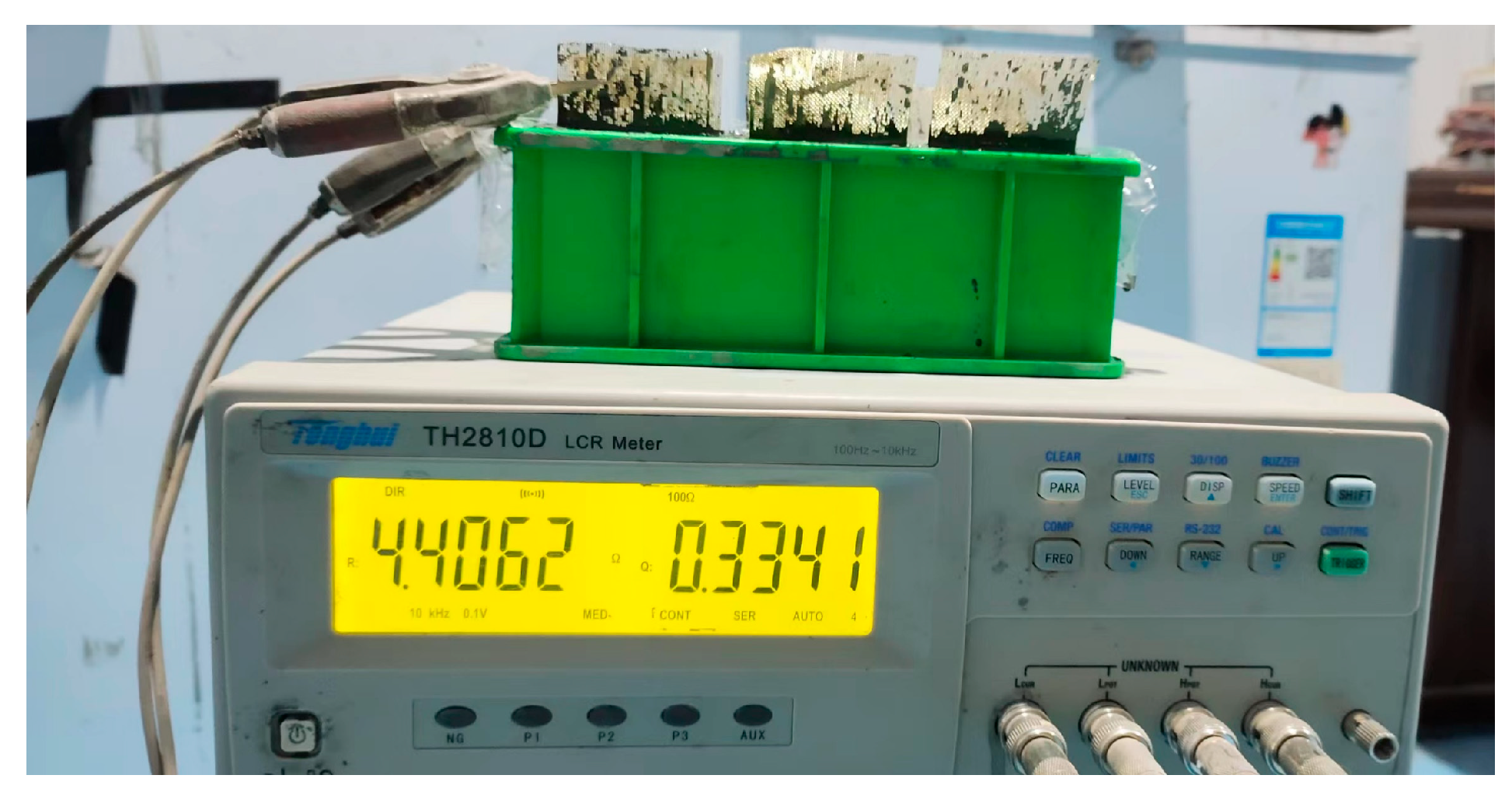

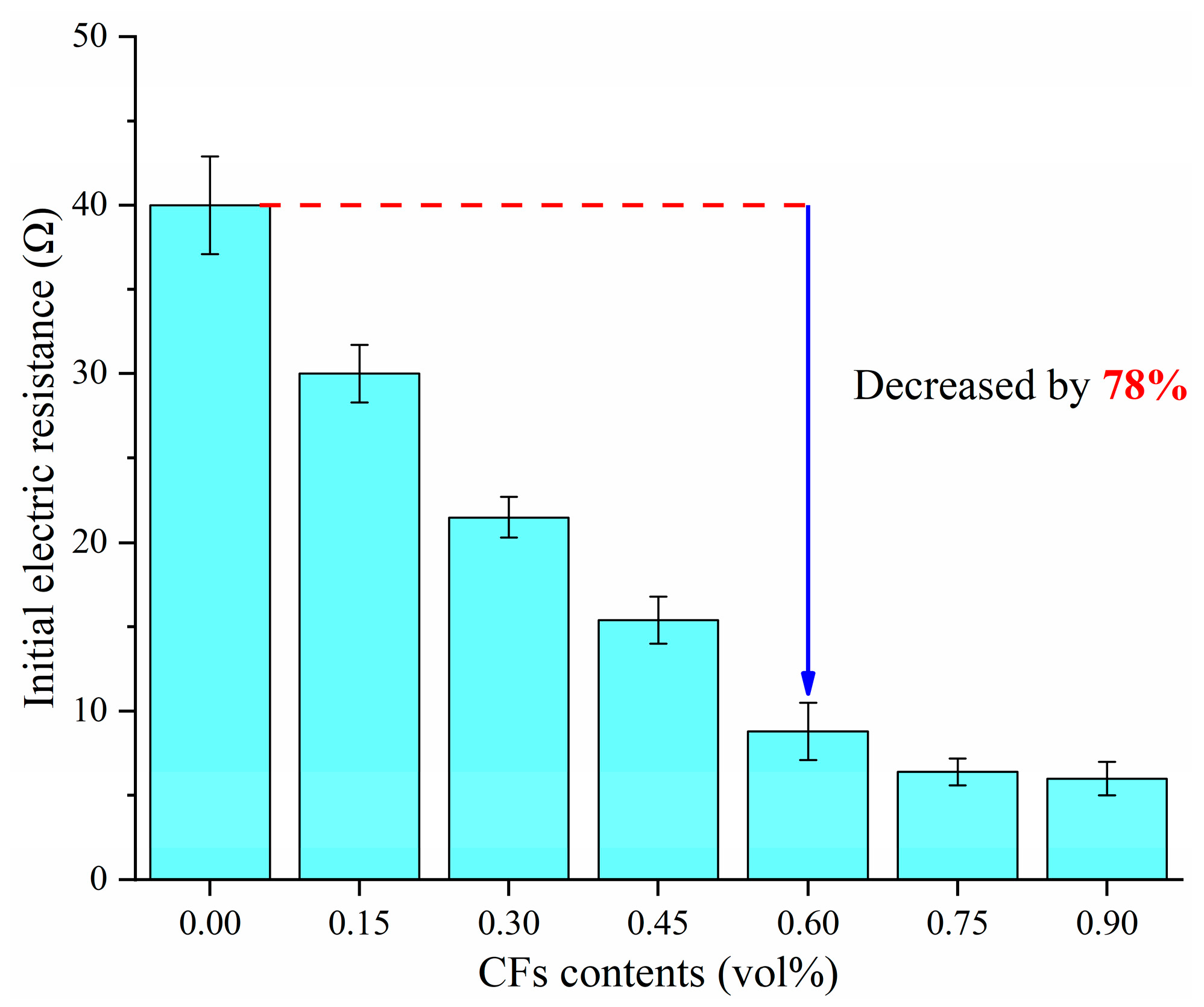
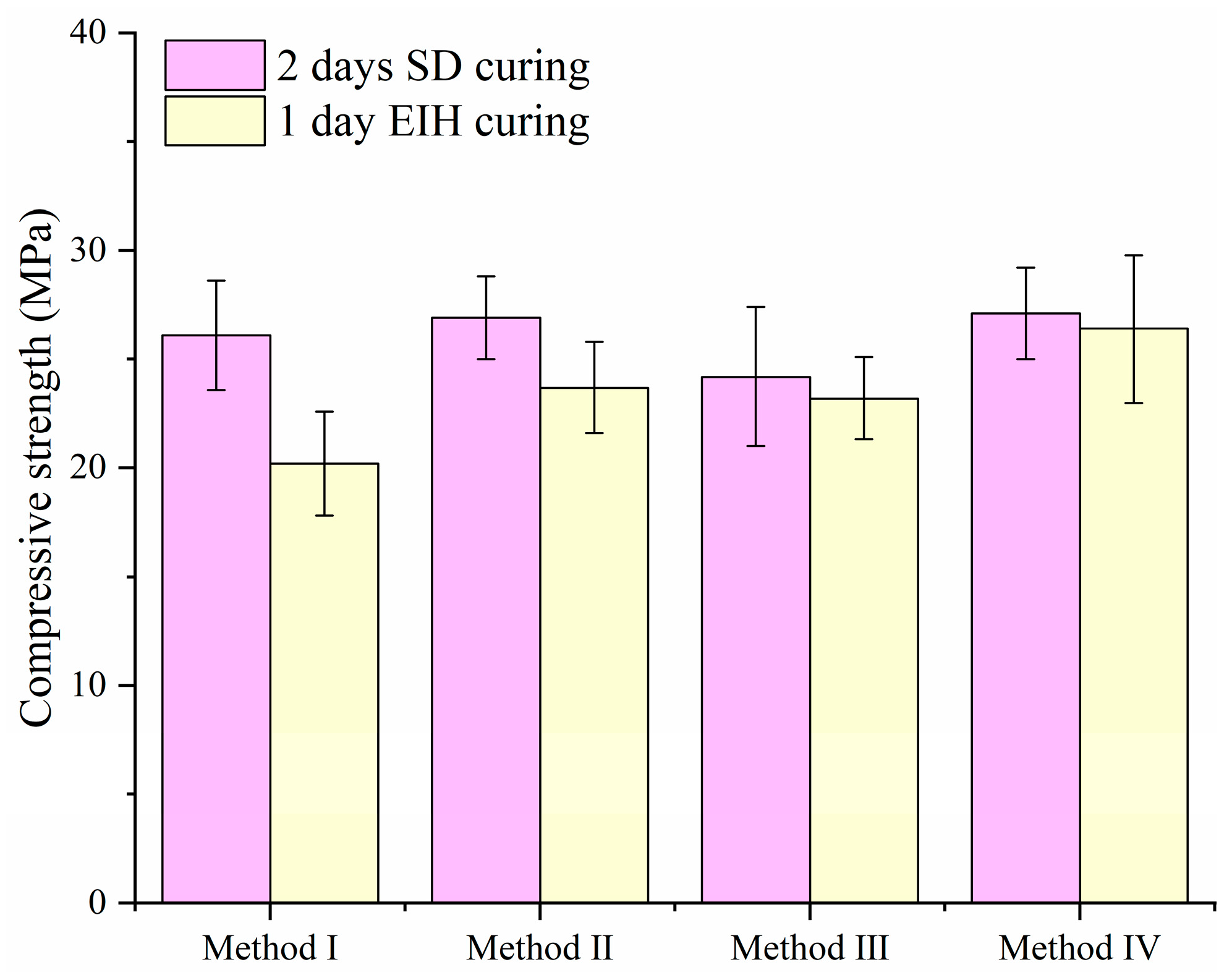
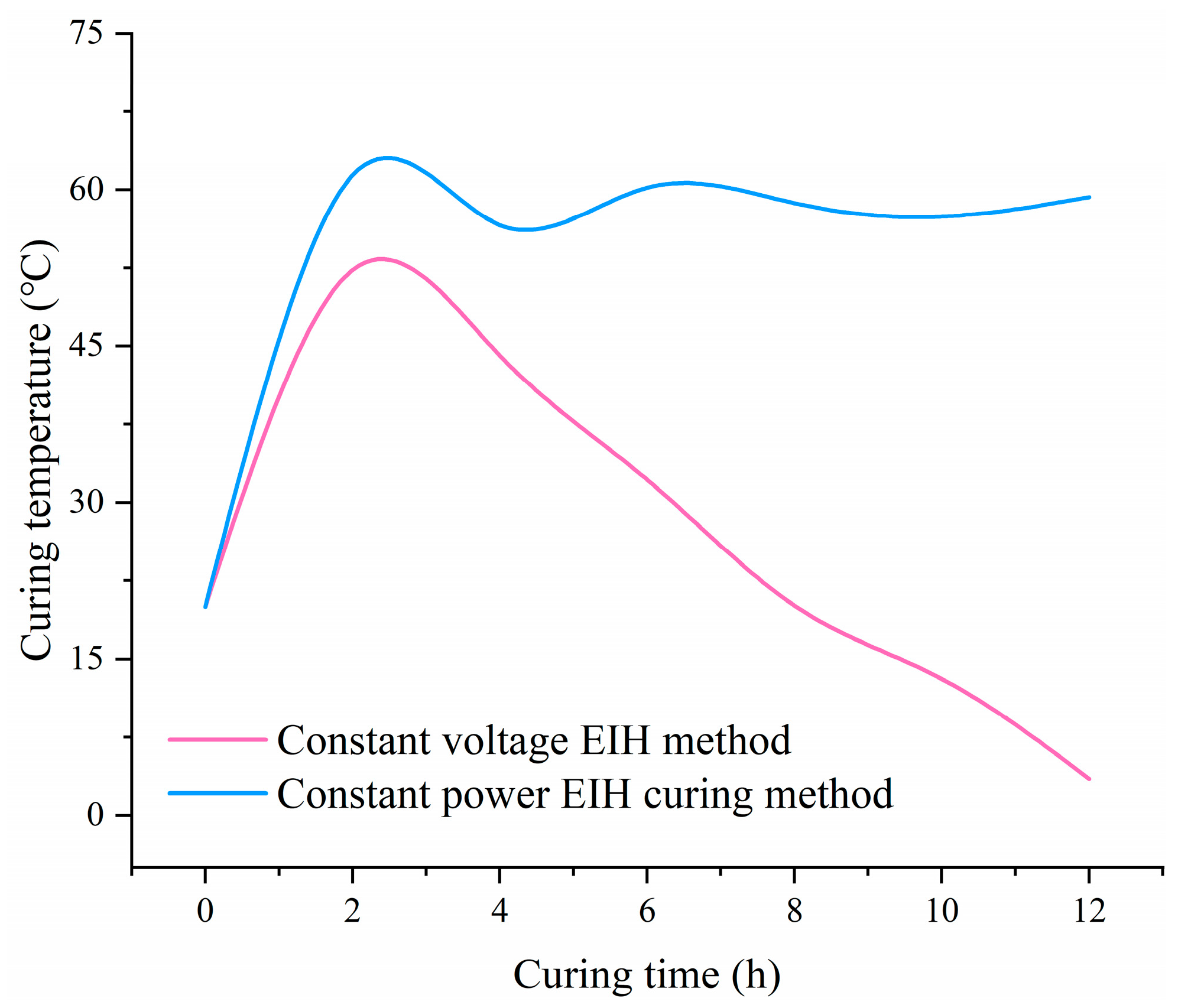
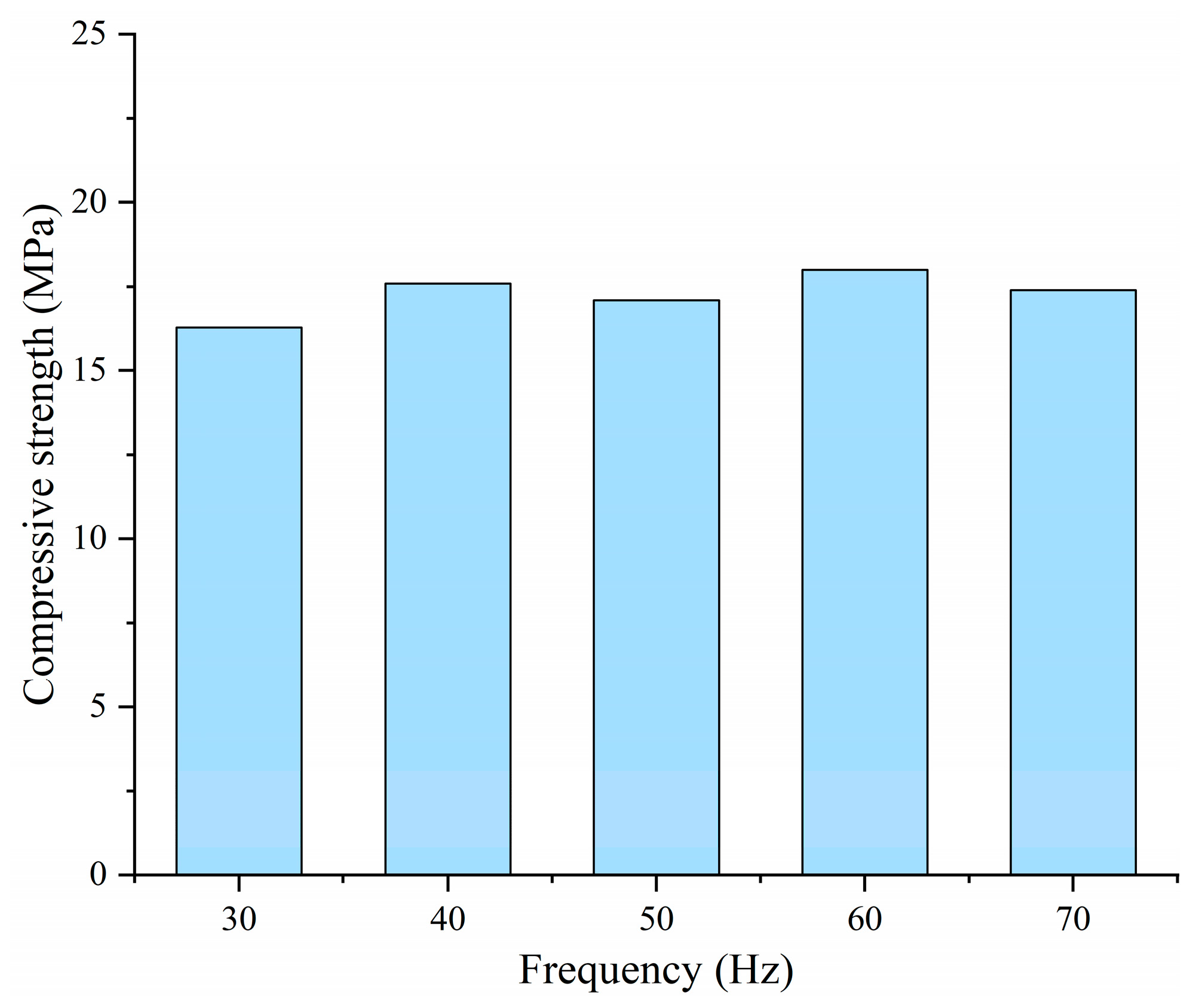
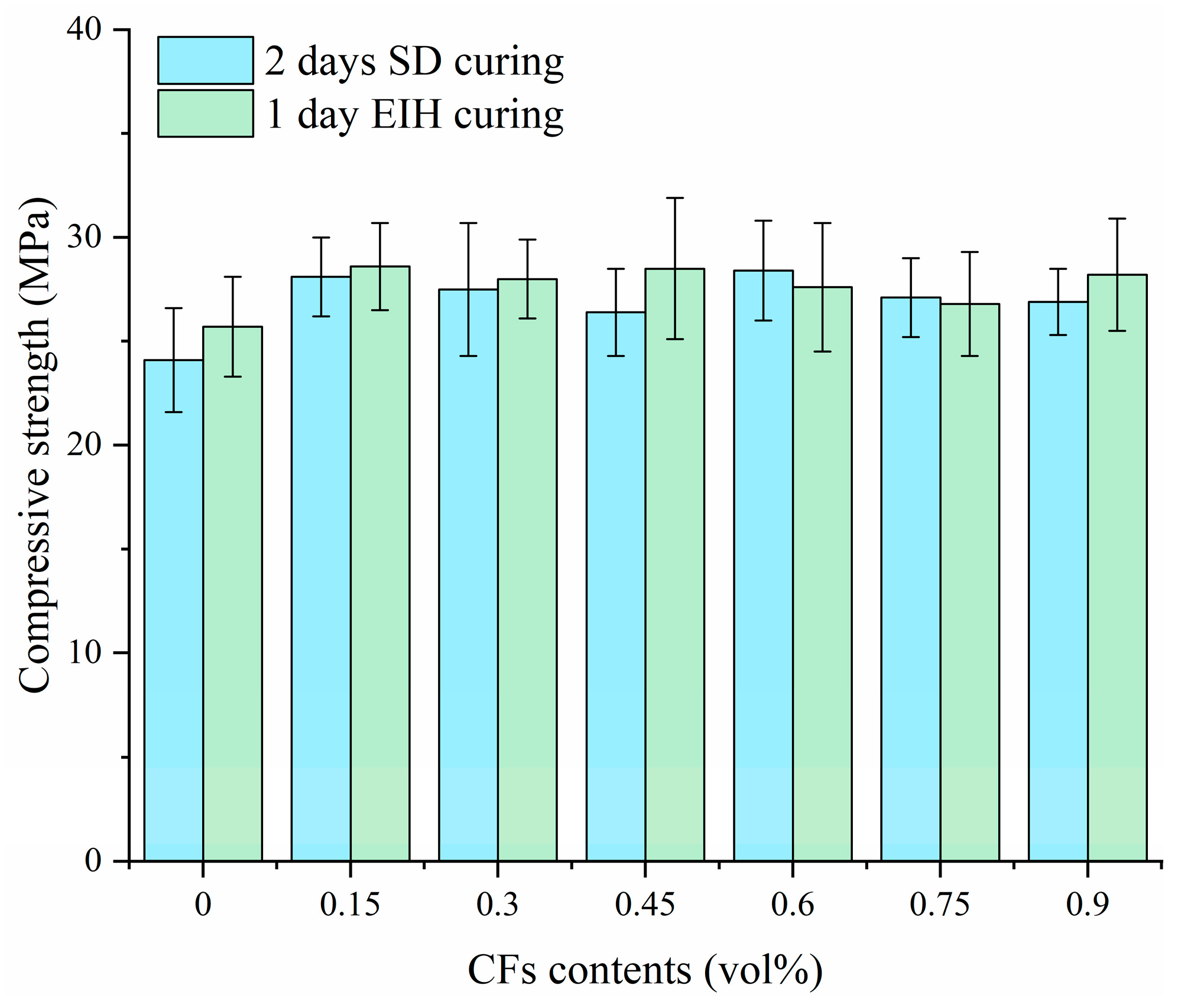
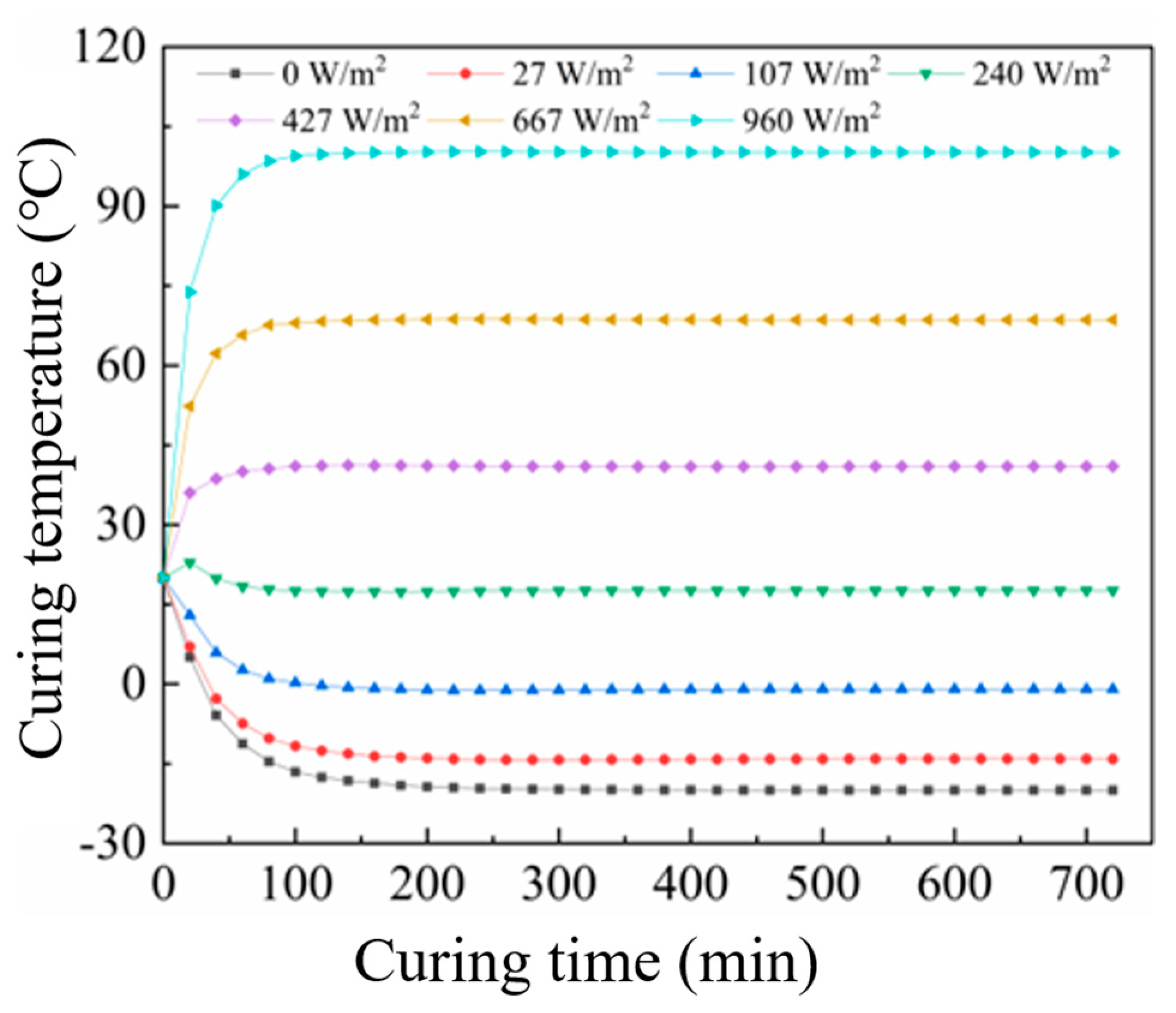
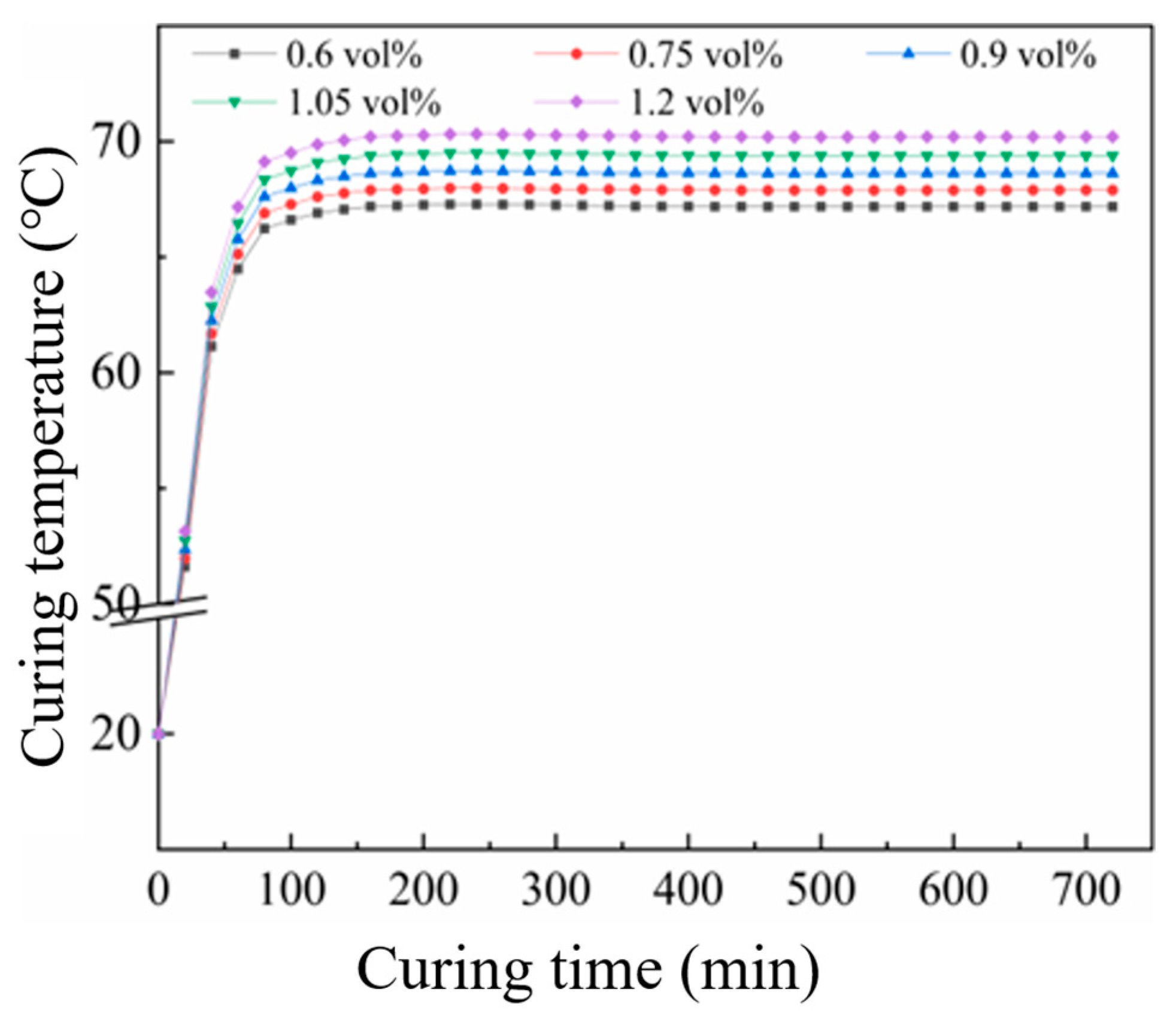
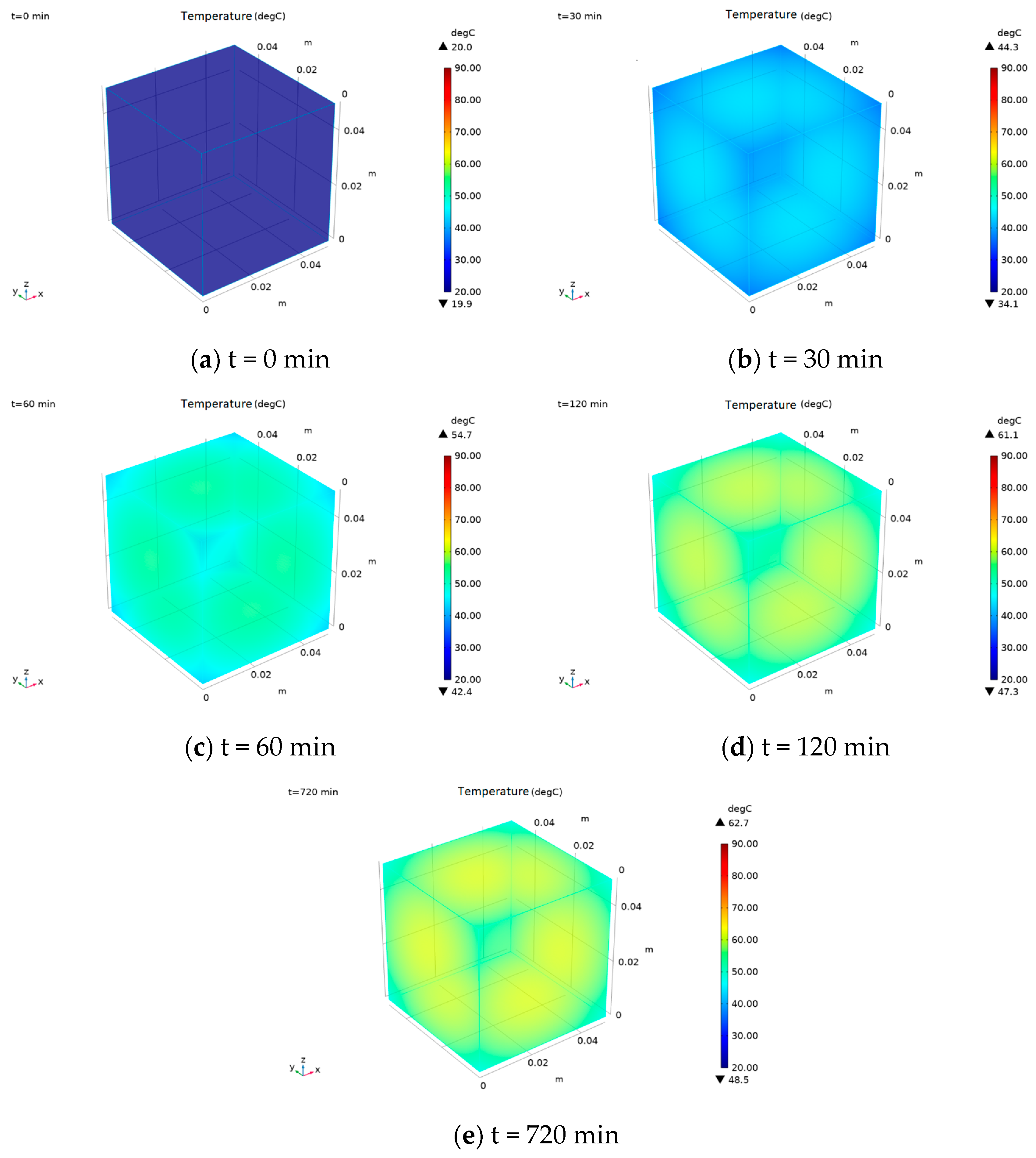
| Chemical Composition | CaO | SiO2 | Al2O3 | Fe2O3 | SO3 | MgO |
|---|---|---|---|---|---|---|
| Content (wt%) | 63.15 | 20.87 | 5.38 | 3.64 | 2.33 | 1.64 |
| C3S | C2S | C3A | C4AF |
|---|---|---|---|
| 57.23 | 18.01 | 7.21 | 11.34 |
| Addition Sequence | Mixing Methods | |
|---|---|---|
| Method I | First, the CFs and cement were added, followed by the addition of water, and the sand was finally incorporated. | The CFs and cement were slowly stirred for 3 min; after adding water, the mixture was further slowly stirred for 3 min followed by another 3 min of mixing after adding sand. |
| Method II | First, the CFs, cement, and sand were added, and then the water was incorporated. | The CFs, cement. and sand were stirred slowly for 3 min; after adding water, the mixture was slowly stirred for 3 min, followed by 3 min of quick stirring. |
| Method III | First, the CFs, cement, and sand were added, and then the water was incorporated. | The CFs, cement, and sand were stirred slowly for 3 min; after adding water, the mixture was quickly stirred for 3 min, followed by 3 min of slow stirring. |
| Method IV | First, the CFs, cement, and sand were added, and then the water was incorporated. | The CFs, cement, and sand were stirred slowly for 2 min, followed by 3 min of quick stirring; after adding water, the mixture was quickly stirred for 3 min. |
Disclaimer/Publisher’s Note: The statements, opinions and data contained in all publications are solely those of the individual author(s) and contributor(s) and not of MDPI and/or the editor(s). MDPI and/or the editor(s) disclaim responsibility for any injury to people or property resulting from any ideas, methods, instructions or products referred to in the content. |
© 2025 by the authors. Licensee MDPI, Basel, Switzerland. This article is an open access article distributed under the terms and conditions of the Creative Commons Attribution (CC BY) license (https://creativecommons.org/licenses/by/4.0/).
Share and Cite
Xie, J.; Zhang, Y.; Tian, W.; Zhang, Z.; Wang, W. Effect of Curing Parameter on the Performance of Electric-Induced Heating-Cured Carbon Fiber-Reinforced Conductive Cement-Based Materials: Experiment and Finite Element Method Analysis. Materials 2025, 18, 4057. https://doi.org/10.3390/ma18174057
Xie J, Zhang Y, Tian W, Zhang Z, Wang W. Effect of Curing Parameter on the Performance of Electric-Induced Heating-Cured Carbon Fiber-Reinforced Conductive Cement-Based Materials: Experiment and Finite Element Method Analysis. Materials. 2025; 18(17):4057. https://doi.org/10.3390/ma18174057
Chicago/Turabian StyleXie, Jiabin, Yishu Zhang, Weichen Tian, Zhanlin Zhang, and Wei Wang. 2025. "Effect of Curing Parameter on the Performance of Electric-Induced Heating-Cured Carbon Fiber-Reinforced Conductive Cement-Based Materials: Experiment and Finite Element Method Analysis" Materials 18, no. 17: 4057. https://doi.org/10.3390/ma18174057
APA StyleXie, J., Zhang, Y., Tian, W., Zhang, Z., & Wang, W. (2025). Effect of Curing Parameter on the Performance of Electric-Induced Heating-Cured Carbon Fiber-Reinforced Conductive Cement-Based Materials: Experiment and Finite Element Method Analysis. Materials, 18(17), 4057. https://doi.org/10.3390/ma18174057






